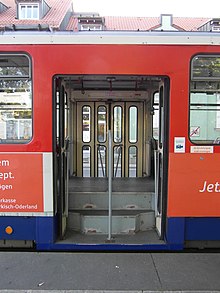High floor
High-floor , more rarely also called high-floor , is a term that is used to distinguish road , city and rail vehicles as well as omnibuses or trolleybuses in conventional construction from those in low-floor technology .
High-floor rail vehicles usually have a level floor that is between 76 centimeters and one meter above the top of the rail . For reasons of accessibility, attempts are being made to standardize the height in order to enable step-free access from elevated platforms of the same height.
The high construction costs of elevated platforms and the problem of making them compatible with urban planning are an important point of criticism when converting existing tram networks into light rail networks, especially when there are many stops in the street. This problem was a major driving force behind the development of low-floor technology, with which the retrofitting of elevated platforms can be avoided.
Today in Germany all underground trains , most S-Bahn trains and many light rail vehicles are designed as high-floor networks. A notable exception is the Cologne Stadtbahn , where a decision was made in the mid-1990s to separate the network, which is only partially equipped with elevated platforms, into a high-floor and a low-floor network. In contrast to light rail routes in the tunnel, which are often provisionally equipped with low platforms or ballasted , there is a novelty in Germany in Düsseldorf ( Wehrhahn line ) and Dortmund ( east-west line ) each with an underground light rail line with platforms for low-floor vehicles is equipped and is to be operated permanently with low-floor vehicles in order to avoid stop conversions on the adjacent tram routes, although tunnels with high-floor platforms already exist in both cities.

